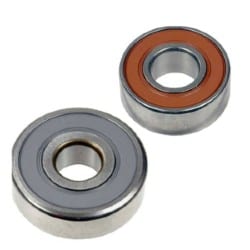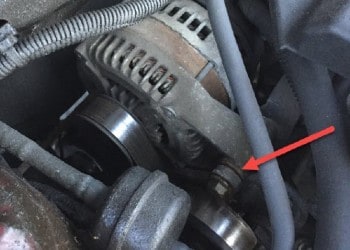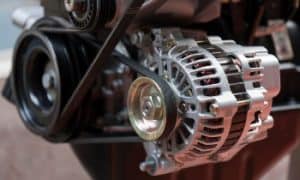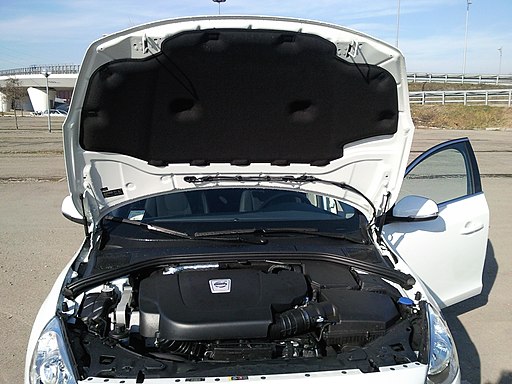With so many electronics built-into vehicles these days, an issue in your electrical system can quickly become much more than an inconvenience. Since the entire system relies on the alternator, it’s a common culprit of electrical failures. When my alternator started making a loud whining noise, I knew a solution was needed quickly, before it snowballed into a much larger problem for me to deal with.
Before you can figure out how to fix alternator noise, you’re going to need to properly diagnose the issue. Let’s first discuss how you can pinpoint the problem by identifying what noises a failing alternator makes, as well as other signs that yours may be at the end of its lifespan.
Once you’ve diagnosed the alternator as the source of your noise, I’m going to provide several simple ways for you to fix it. If that doesn’t work, then we’ll briefly discuss how you can replace your alternator and save hundreds of dollars over going to a mechanic.
For more helpful information on diagnosing and fixing automotive noises coming from under the hood, please see our articles:
How to Soundproof a Noisy Water Pump
How to Quiet Noisy Strut Mounts

What is an Alternator?
You’ve probably heard of an alternator, but not everyone knows what function it performs. Your vehicle is wired with sensors and electronics everywhere, from the gauges in your dash to sensors in your tires, and more sensors throughout your engine, the cabin, etc. With so many electronics requiring power, how does a single battery keep everything running?
It doesn’t. That’s the job of the alternator.
While your engine is running, a belt spins the pulley on the alternator, allowing it to generate electricity. This electricity is used to power everything in your vehicle while it simultaneously charges the battery. The battery itself is primarily for starting the vehicle but the alternator takes over once it’s on.
Since the entire electrical system revolves around the alternator and the vehicle relies on the electrical system to run, it’s safe to say that the alternator is crucial for the proper function of any automobile. When yours starts to fail, it could leave you in an unfortunate predicament. But how will you know when it starts to go bad?
What Does a Bad Alternator Sound Like?
Certain noises coming from the engine compartment can be a sign that your alternator is failing. But what sound does a bad alternator make? Depending on what part of the alternator is going bad first, you may experience any of the following noises.
Alternator Whining Noise
A common sound made by failing alternators is a very high pitched whining noise that you’ll hear when the engine is running. When the RMPs increase, such as when you accelerate, you’ll hear the noise get higher in pitch as the pulley spins faster.
Grinding Noise
If you’re hearing a loud grinding sort of noise coming from your engine compartment, it’s likely caused by the alternator. You’ll hear the grinding get louder as you rev the engine.
Squeaking
Though not as constant as the whining noise, a repetitive chirping or squeaking can be another sign of an alternator going bad. This will be very high pitched and the frequency of the squeak should increase as the engine reaches higher RPMs.
Squeaking When You Turn Alternator Pulley and the Car Is Off
We already mentioned squeaking while the vehicle runs. Still, another sign is whether the alternator pulley squeaks when you turn it by hand with the engine off.
Make sure the engine is cool before you do this test. Turn the alternator pulley by hand and listen for any squeaks as it spins. If you hear squeaking from it, then you’ll likely need to replace the noisy alternator bearing or alternator.
Knocking Noise
A knocking noise can be caused by one of several things relating to the alternator. A broken belt could flap around the engine compartment and make a knocking noise as it comes in contact with other parts. Also, a broken bearing may create a knocking sound as it’s jostled around inside the housing. A final option is that a loose bolt on the alternator could be allowing it to move around while the engine runs.
Common Causes of Alternator Noise
We’ve discussed the sounds that may warn you that an alternator is on its last leg. But what is causing the noise you hear? Let’s cover a few common causes of a noisy alternator.
Worn Alternator Bearings
 To generate electricity, the serpentine belt on your engine spins the alternator pulley at thousands of rotations per minute. Bearings keep everything smooth and allow the pulley to spin at such speeds.
To generate electricity, the serpentine belt on your engine spins the alternator pulley at thousands of rotations per minute. Bearings keep everything smooth and allow the pulley to spin at such speeds.
Of course, after thousands of hours of spinning at high speeds and traveling thousands of miles, those bearings will start to accumulate some wear and tear. When they get too worn out, they can go bad and start to create loud grinding noises that indicate a need for replacement. If one breaks, you may hear it knocking around as the alternator spins.
Loose or Worn Alternator Belt
The alternator belt (also known as the serpentine belt) passes through several pulleys on the engine. When the crank turns, the belt pulls the other pulleys and causes them to spin, including the alternator pulley.
Naturally, the friction caused by spinning through so many pulleys at high speeds will eventually wear the belt out. As it starts to reach the end of its lifespan, you’ll hear it start to make some sounds of complaint like squealing, squeaking, and whining.
Loose Alternator Bolt
 Vehicles experience a lot of vibration and jarring, so it’s not uncommon for things to loosen up over time.
Vehicles experience a lot of vibration and jarring, so it’s not uncommon for things to loosen up over time.
If one of the bolts holding your alternator in place begins to get loose, then you may hear the alternator moving around as the engine operates.
Signs of a Failing Alternator
Warning Light
Since they’re loaded up with electronics, newer vehicles tend to have sensors on most of the working parts, including the alternator. As such, you’ll likely see a warning light illuminate on your dash when somethings amiss with your alternator.
You may just see the battery sign light up that signifies an issue somewhere in the electrical system. Your vehicle may instead have an indicator light that’s specifically for the alternator, in which case it may say ALT for alternator or GEN for generator.
Dim Headlights
While your vehicle is running, the alternator is responsible for powering the electrical devices, including your headlights. If your headlights seem to be losing power or you notice that they’re just not as bright as usual, there’s a good chance that it’s due to an alternator that’s going bad.
Flickering Headlights
Your alternator should have no problem powering several different functions at once, such as headlights and brake lights. Normally this isn’t an issue, but if your alternator is dying, then it won’t have enough power for everything.
With your car in park and the headlights on press the brakes. If your alternator is functioning properly, you shouldn’t notice a difference. If your alternator is dying, you’ll see the headlights flicker when you press the brakes.
Dead Battery
One of the primary jobs that the alternator performs is recharging your car’s battery while you drive. If it’s not recharging properly, then your battery may get too low in charge to start your vehicle.
However, a dead battery isn’t always a sign of a failing alternator since each battery has a limited lifespan and will eventually die anyway, even if your alternator is working properly.
Alternator Making Noise
One of the easiest to spot signs of an alternator going bad is that it starts making noise. As we’ve already discussed, squealing, squeaking, grinding, whining, and knocking noises can all be made by a dying alternator.
Car Won’t Start Properly
If your vehicle is having trouble starting or it’s cranking and turning over quite a few times before actually starting, then your alternator may be to blame. This could also be caused by a dead battery though, so you’ll need to perform a test to see which is the culprit.
Stalling While Running
When your vehicle starts properly but then quickly dies or it just stalls out on you while it’s running, then a dying alternator is likely the cause. Your vehicle may start just fine because the battery has sufficient charge.
Once the engine is running though, the alternator takes over the electrical duties. If it’s no good, then the engine will die when the alternator takes over for the battery.
Electrical Malfunctions
Since the entire electrical system hinges around the alternator, you may experience a multitude of small electrical malfunctions when the alternator starts to go bad. You may notice issues with the power locks or power seats. Power windows may operate slower than usual and the lights in your dash and console may become dim or may even flicker.
Burning Smell
It’s not uncommon for failing alternators to emit a smell like burnt rubber. If the belt is going bad, is misaligned, or is experiencing too much friction, it may be the cause of the burning smell. Alternatively, an overheated alternator can also be burning the wires attached to it, which can cause the same sort of odor.
How to Quiet a Noisy Alternator
Now that we can identify the signs of a failing alternator and we know what sounds to listen for, it’s time to discuss some solutions. The alternator tends to be situated on top of your engine near the front, so you should be able to access it without any difficulty. Since it’s an easy part to get to, you may be capable of performing most or all of these repairs by yourself.
1. Test Alternator First
Before you go making any sort of repairs, you need to be certain that the alternator is your problem. If you have a simple voltmeter available, you can easily test to see if the alternator is working or not.
Connect your meter leads to their corresponding battery terminals and set your meter to read DC voltage. If your battery is properly charged and working as it should, you’ll see a reading of 12.6.
With the engine running but the accessories and lights all turned off, you should see a reading of 14.2 to 14.7 volts if your alternator is functioning properly. If yours reads higher than this, it could overcharge the battery causing damage to it. When the reading is lower than this, it indicates that your alternator can’t meet the demands of your vehicle.
2. Check the Condition of the Belt
Years ago, serpentine belts were made out of neoprene and they developed visible cracks with age that indicated it was time for a replacement. As technology improved, manufacturers switched to a new material called EPDM, which no longer cracks the way belts used to. So how can you tell now that a belt is worn out?
These modern belts last about twice as long as the old neoprene ones. They also wear differently. The grooves on the belt will continue to get larger and larger until the belt runs out of material on the other side.
First, you can look for visible signs of wear on the backside of the belt. But to properly check a belt now, you’ll need a small plastic gauge that measures the size of its grooves. If the teeth on the gauge have room to move while inserted in the grooves of the belt, then the belt is ready to be replaced.
3. Tighten Bolts
Sometimes the bolts that hold your alternator in place become loose with time thanks to all the vibration of the motor and from driving. This is pretty easy to remedy with a basic socket set.
You’ll need to locate your alternator bolts first, there should be three or four. Then you’ll need to find the proper sized socket. Simply hand tighten each bolt until they’re snug.
4. Replace the Serpentine Belt
 If your vehicle’s serpentine belt is worn, replacing it is a relatively easy procedure that you can perform at home with a socket set. You’ll need to make sure you get the correct belt for your car, it’s vehicle specific. One I suggest is the Bando OEM Quality Serpentine Belt.
If your vehicle’s serpentine belt is worn, replacing it is a relatively easy procedure that you can perform at home with a socket set. You’ll need to make sure you get the correct belt for your car, it’s vehicle specific. One I suggest is the Bando OEM Quality Serpentine Belt.
I also recommend taking a picture of your belt setup before removing it so that you have a reference to go by when you put the new one on. There are quite a few pulleys to go around and it can get confusing!
Start by locating the tensioner pulley. It will have a nut in the center that you can turn with a socket wrench. When you do, it will move the whole pulley and loosen the tension on the belt, allowing you to slip the belt off.
You’ll then install the new belt in the same manner. Get it wrapped around all the pulleys in the proper direction except for the tensioner pulley. Pull the pulley out of the way using your socket wrench and slip the belt over it.
5. Replace the Alternator Bearing
Replacing the alternator bearing is a bit more labor-intensive than some of the other methods we’ve discussed, but doing it yourself can save you quite a bit of money. You’ll need to remove the whole alternator for this one.
Make sure you disconnect the battery first. Then remove the serpentine belt by loosening the tensioner pulley with a socket wrench.
Disconnect the wire harness that’s attached to the alternator. Then remove all the bolts that hold the alternator in place. You can now remove it and transport it to a bench.
Insert a socket attached to an impact wrench into the pulley of the alternator and remove the large nut.
On the backside of the alternator, remove the bolts and screws that hold the outer plate on. Then remove the housing bolts and any screws around the outside. The bearing is pressed into the housing, so you may have a tough time removing the housing.
You can hit the shaft from the front to remove the bearing assembly and gain access to the bearing. Then you can remove the large bearings with a hammer. Once you replace the bearings, simply reassemble the alternator.
6. Replace the Alternator
 If you take your vehicle to a shop for an alternator replacement, you may pay many hundreds, nearing a thousand dollars. By doing it yourself, you can get cheaper parts and pay nothing for the labor. For instance, this one from ACDelco is a fraction of the cost that a mechanic’s chop will charge you for a new one.
If you take your vehicle to a shop for an alternator replacement, you may pay many hundreds, nearing a thousand dollars. By doing it yourself, you can get cheaper parts and pay nothing for the labor. For instance, this one from ACDelco is a fraction of the cost that a mechanic’s chop will charge you for a new one.
Start by disconnecting the battery. Next, remove the serpentine belt. Use a socket wrench to move the tensioner pulley and loosen the belt for removal.
Disconnect the wire harness from the backside of the alternator. Then remove the bolts holding it in place so you can remove it.
Put the new alternator in place and insert the bolts. Tighten them down until they’re all fully snug. Then reattach the wire harness into the back.
Replace your tensioner belt and re-connect the battery.
How Long Can You Drive With a Bad Alternator Bearing
Since it can be a costly repair at a mechanic or it could take a few hours of your time to perform yourself, you may wonder how long you can put off repairing your alternator with a bad bearing.
The truth is, there’s no way to know how long it will last. It might last several months just making a noise and doing nothing worse. Or, it may end up failing the next time you start your car. However, driving with a dying alternator can cause other problems, such as damaging the battery. It’s best to take care of this problem as quickly as possible so it doesn’t grow into something larger.
Alternator Bearing Replacement Cost
At a mechanic’s shop, they’re going to want to replace the whole alternator. If the alternator bearing noise are the only problem, then you can save a boatload by replacing bearings yourself, as I described in an earlier section.
You can find an alternator rebuild kit for about $25-$35, which will include the bearings you need. Considering the average cost for a professional to replace your alternator is between $579 and $759, this is a pretty substantial saving.
If you don’t want to mess with pulling your alternator apart but you still want to save some money, replacing your alternator will cost a bit more than just replacing the bearings, but it will save you some time as well. You can find an alternator such as this ACDelco for a fraction of the cost of getting it replaced at a shop. Then follow the directions as laid out previously and you’ll have saved a small fortune.
Conclusion
A lot of sensors and electronics across your vehicle are relying on your alternator to keep them powered. If yours starts to fail, you’re going to see several clear indications like alternator bearing noise or loud squealing sound.
Now that you know exactly what they are, you should be able to recognize them for what they are when you see them. Moreover, you know exactly how to pinpoint and fix the problem, even if it means replacing the alternator.
If you found this article helpful, please feel free to share it so that others can find it as well. If you have any questions or comments, I’ll try to respond to any left in the comments box below as quickly as possible.
You May Also Like:





What if you still get noise from alternator even after replacing it 2 times with different types?
The serpentine belt tensioner and idler pulley bearings can whine too.
Hi Fergus,
Thanks for the information.
Terry
I had noticed that my positive terminal cable was connected to the back of the alternator and I was hearing the high pitch whining noise. So what my plan was to go head and disconnect the positive terminal cable that was connected from the battery to the alternator so I can see if I can take away the high pitch whining noise and it did work. But as soon as I did that my car battery light indicator came on. Does that mean I have a bad battery or should I reconnect the positive terminal cable back to the alternator? But if I do that then the high pitch whining noise will start again. Should I connect anything else to the alternator besides the harness to it or should I connect the positive cable back to the alternator but like I said that the high pitch whining noise will come back on. What is your solution for me or what should I do?
Thank U, now I can.see
clearly now. I understand the terminology of the alternator purpose. Thanks again.
Hi Selket,
Good to hear we could help.
Terry
I have 2011 Ford Focus! the Alternator makes a squawking noise. Its a new Alternator. The mechanic tried four different Alternators. Two rebuilt Alternators and two new ones. They all make the same noise. He said Ford said that the problem is caused by the plastic housing around the alternator to protect it from the exhaust. The car has a new serpentine belt, new belt tensioners, idler pully and water pump. I talked to another mechanic today. He said that sound was definitely coming from the Alternator. He was stumped by this problem. He is going to do some research on this problem to hopefully find the answer. Hard to believe that all the replacement Alternators have the same problem. Its a good running car and this noise is awful. Have you ever come across a problem like this one? Any help that you can offer me would be greatly appreciated. Thanks!
I have a 2011 Ford Focus. The Alternator make a annoying squawking noise. This a new Alternator. The mechanic tried four different Alternators, two rebuilt ones and two new ones and they all make the same noise. The car has a new Serpentine belt, new belt tensioners, new idler pully and a new water pump. the Mechanic contacted Ford and there excuse was that it was caused by the plastic housing on the Alternator to protect it from the exhaust heat. So does this mean that all replacement Alternators are faulty. I checked with another mechanic and he was stumped by this. Have you ever run into anything like this. I would like to solve this problem. I would sure appreciate any help or knowledge from you to help me solve this mystery noise.
Hello, I recently had to get my alternator replaced on my 2012 Nissan Rogue. It started out making a slight knocking noise. Over time it got louder, and after a while along came a burning hot smell. It was especially noticeable when I would make long commutes. It still drove it for months. Several people said it was safe to drive, so I did. Except on one very hot day I drove a long distance and I parked, but stayed in the car and I kept the car running with the air-conditioner on. After a while, I noticed that all the lights on the dashboard come on. Then the car shut off. I tried to start it but the battery had no power. I called for a jump and it took a while to get it going, but it finally started up. When I put it in gear, it shut off again. My mechanic replaced it with a brand new alternator. Three months later I’m hearing dejavu all over again. Just like before. So, I am wondering could the alternator be the culprit again? Or could there be something else causing this? Just as a sidebar, last week someone in the neighborhood sliced one of my tires and now I am wondering if it’s possible for someone to be able to access and loosen something like a bolt or fastener to my alternator from underneath my car? Or am I overreacting here?
Hi D.J.
Even if the new alternator is a re-built you should have at least a 90 day warranty on it. I would go back to the mechanic prepared to be a little grumpy. It is new. You should not have to diagnose the problem. Although I would look at how the alternator aligns with the belt. If it is not lined up next to perfectly, the belt is going to put some stress on the pulley and shaft and bearings. Also make sure the belt is tensioned correctly. A belt that is too tight or too loose will not do your alternator any good.
Terry
Is it possible that the water pump could be making a similar noise when it is going bad? And if so, how would I determine that? Thanks for your help.
J. T.
Hi J T,
You may hear some of the same noises from the water pump, although the ones I have heard going bad tend to just scream. Get louder as you speed up. If a water pump is not working properly, you will notice the motor running hotter if you have a gauge. Try taking the belt off and turning it by hand. You might find some resistance, wobble, or hear grinding–all of which probably mean that you need a new one.
Running it into a mechanic that you trust, who will just listen for a couple of minutes is probably the easiest way to get a diagnoses.
Terry